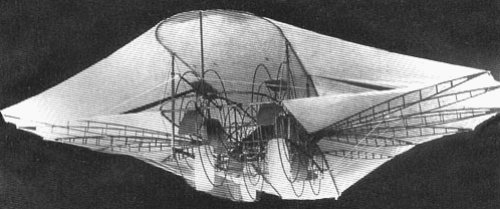Ezekiel Flys
Today, Ezekiel's Wheel. The University of Houston's College of Engineering presents this series about the machines that make our civilization run, and the people whose ingenuity created them.
As we close in on the Wright Brothers' Centennial this Autumn of 2003, the counter-claimants rise up. Whitehead, Langley, Stringfellow, Maxim, Pearse, Montgomery, Broadbeck — I won't even try to complete the list. So many people got off the ground before the Wrights and so many more claimed to've done so.
Instead, let's meet a Texas claimant, the Reverend Burrell Cannon. Writer Michael Hall tells how the 52-year-old Cannon decided, in 1900, that he'd been called by God to replicate Ezekiel's Wheel. Cannon had been running a lumber mill in the East Texas town of Pine. He'd also spent fifteen years studying the Book of Ezekiel, and now he set out to build an Ezekiel Wheel flying machine.
He was businessman enough to know he'd need money and backers. So he sold his mill and moved to the nearby cotton center in Pittsburgh, Texas. There he preached -- both the Gospel and his aeroplane. The times, says Hall, were optimistic. He found backers.
Cannon sold $25,000 worth of stock, starting at $25 a share, and he began building a one-man 26-foot prototype. But his real goal was far more ambitious. He meant to create a 125-foot machine capable of carrying twenty tons. And, using God's own design, how could he fail? Cannon finished his prototype aeroplane.
It was quite a machine -- an almost-circular flying-wing, with a secondary lower wing below. The supporting structure was a light tubular metal frame. The Book of Ezekiel had spoken of the construction being "as it were a wheel within a wheel." It'd gone on to say, "the spirit of the living creature was in the wheels." So Cannon created two pairs of wheels, nested below the wings.
The animating spirit, an eighty horsepower engine, was placed between the wheels. The outer pair of wheels was eight feet in diameter. They taxied the airplane up to takeoff speed. The inner pair was smaller and faster moving -- a set of paddle wheels was meant to drive the aeroplane once it was airborne.
That might set off alarm bells. Paddle wheels work on a steamboat because they push against the water at the bottom, then coast around through the air on top. But Cannon devised means for retracting the paddles in the upper return stroke. He also meant to control the machine in flight by varying the paddle speeds.
Then, in 1902, one of Cannon's workers flew the machine. It gained speed, took off, seemed to drift in the air, began vibrating violently, and then crashed into a fence. The flight, if you can call it that, had covered a distance of 167 feet.
And so Cannon lost his backers and moved back to Pine — with his airplane. But he was at it again, nine years later — more backers, another airplane. This one crashed into a telephone pole. Hall ends his surreal story with a marvelous paraphrase. He says, "Cannon's reach exceeded his grasp — by an inch or by a mile. It doesn't matter. What's a heaven for?"
I'm John Lienhard, at the University of Houston, where we're interested in the way inventive minds work.
(Theme music)
M. Hall, Two Wings and a Prayer. Texas Monthly, Jan. 2003, pp. 100-103, 130-131. (My thanks to Mechanical Engineering colleague, Charles Dalton, for providing me with this source.)

Photo from a contemporary postcard provided by The Pioneers.
Another fine source of material about Cannon's Ezekiel is: http://web.archive.org/web/20041205181032/http:/www.davidicke.net/emagazine/vol4/ezek.html
The relevant text in the Book of Ezekiel (King James Version, 1:15-23) is:
Now as I beheld the living creatures, behold one wheel upon the earth by the living creatures, with his four faces. The appearance of the wheels and their work was like unto the colour of a beryl: and they four had one likeness: and their appearance and their work was as it were a wheel in the middle of a wheel. When they went, they went upon their four sides: and they turned not when they went. As for their rings, they were so high that they were dreadful; and their rings were full of eyes round about them four. And when the living creatures went, the wheels went by them: and when the living creatures were lifted up from the earth, the wheels were lifted up. Whithersoever the spirit was to go, they went, thither was their spirit to go; and the wheels were lifted up over against them: for the spirit of the living creature was in the wheels. When those went, these went; and when those stood, these stood; and when those were lifted up from the earth, the wheels were lifted up over against them: for the spirit of the living creature was in the wheels. And the likeness of the firmament upon the heads of the living creature was as the colour of the terrible crystal, stretched forth over their heads above. And under the firmament were their wings straight, the one toward the other: every one had two, which covered on this side, and every one had two, which covered on that side, their bodies.
![]()
A different vision of Ezekiel's Wheel from M. Merian, Iconum Biblicarum, Frankfort, 1627.